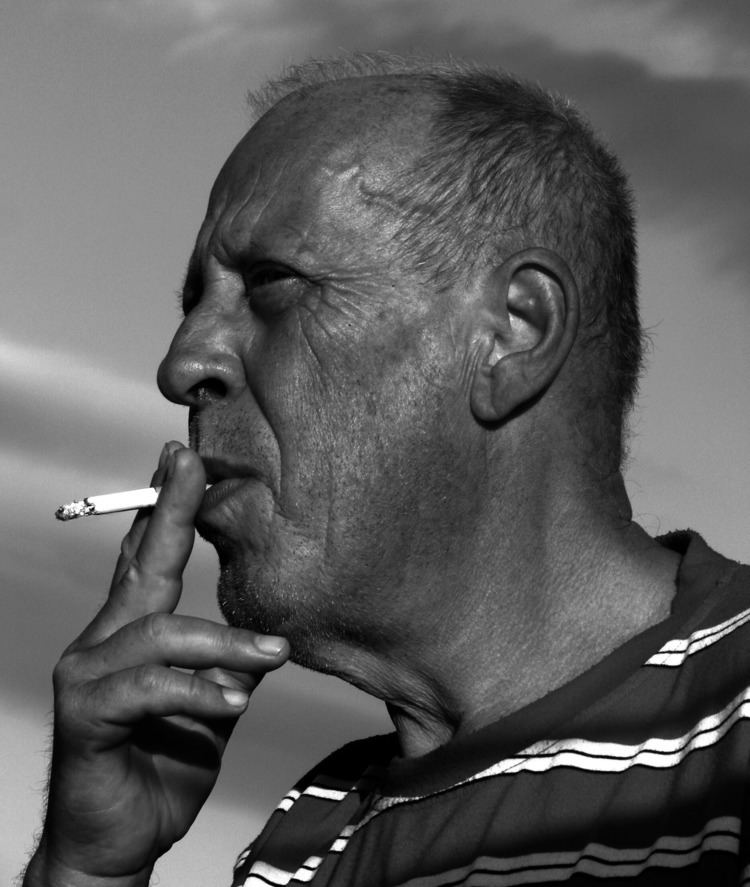Nationality Czech Known for Painting, drawing | Name Bob Rakusan | |
 | ||
21 2015 kaleidoskop 1 bob raku an
Bob Rakušan (born 6 February 1948, Prague) is a contemporary artist creating large-fired enamel works on black steel plate, scrap and salvaged objects, such as stove tops, ovens and various other objects. The works are layered and composed through pattern and screen processes achieving tonal qualities reminiscent of bitmaps, with depth of design and fired enamel embossed plasticity. The works eschew vivid light in their spectrum, with an acute attention to detail. The foundation layers of the enamel are often built on screen techniques inspired by the printing process. The base origins of the work are rooted in drawings, studies and graphic prints. Besides landscapes and the abstract and figurative compositional elements, a recurring ocean theme inserts itself, often unconsciously, into the works, inspired by his longtime occupation as a captain of sailing ships.
Contents
Beginnings

During an early two-year period studying figurative drawing and painting in the studio of Prof. Frantisek Nedved (1966-1968), the artist created a series of drawings (mostly portraits and nudes). Additional early development focused on expressive painting, characterized by dynamic design and structure, with materials including charcoal, ink and pastel. These themes and techniques will later appear in his enamel works.

Conflict was a formative influence during this period, contrasting the desire for individual artistic pursuit with the demands of academic studies at the Academy of Arts, Architecture and Design in Prague (beginning with Prof. Josef Novak, studio of book graphic and poster, Prof. František Muzika, and later with Prof. Milan Hegar). Influenced, and often overridden by the demands of his formal educators, work from this period and beyond is characterized by a shift to Surrealism and a revised color palette. During this period the artist also worked in the technique of dry point and aquatint focusing on portraiture.
In 1969, Bob left the Czech Republic for assignment to a Ceramics factory in West Germany to produce designs for Keramik Fabrik Schardt in Rheinbach, the results being a thematic series of ceramic design templates. It was during this period that the artist also began composing large and small scale mosaic pieces for private collectors. The culmination of this short assignment was an individual show in Bonn at the Opel Autosalon Bachem, which marked the artist’s first independent show. The success of the show resulted in a 2-month delay in his return to University, for which the academic consequences were severe.
70 years
In 1973, after finishing formal studies, Rakušan focused on commercial illustration and graphic arts for a number of magazines, book publishers and companies (posters, logos, advertising and book designs, illustrations for children), while also exhibiting work in the Jaroslav Fragner gallery.
At the end of the seventies, after the birth of his eldest son David, the artist returned to the creation of formal and independent art. This resurrection period is noted by a set of small circular format paintings painted with a canvas and board combined technique. Fantastic landscapes and figure compositions are permeated with poetic melancholy, hints of surrealism and symbolism.
A major turning point in the artist’s career was a group exhibition Mult in Copenhagen in 1981 where the artist’s work was confronted and contrasted with pop art and avant-garde. The contrast left a deep impression that significantly altered the theme and composition of future work.
Resulting from this confrontation of style was a substantial simplification of form, characterized by color, distinct area and bounded by heavy graphical influences. Large scale preparatory works composed of line drawings, gouache, and blanket fields of color formed the basis for a series of oil paintings.
The birth of his second son Luke in 1983; thrust to the fore the reality of life in Czechoslovakia. The stark reality forced the artist to dedicate his efforts to commercial endeavors, magazine graphics and illustration work. The lull of this period is only occasionally interrupted by participation in parades of Czechoslovak artists.
Beginning in 1988, the artist returned to his work full-time. The interim period gave the artist serigraphic and other printing experience from which was drawn a base for a new painterly style with monumentality and overall statement of color technique. This period also sees the production of early enamel work. A collection of early enamels exhibited at the Salon of Prague Artists in the Park of Culture and Leisure (Park kultury an oddechu) gained the attention of both the general and professional public.
Large enamel firing technique
The final exhibition of graphic work occurred in 1989 in the graphics Salon of Applied Arts in Prague, in the Culture and Leisure Park. In 1988, a group exhibition marked the entry into an enamel phase at a group exhibition: New Painting in the Student House of CTU in Prague. During this time and through the end of 1990, the artist’s works also exhibited in a separate traveling exhibition through Germany – (Höchst im Odenwald, Zweibrucken, Darmstadt). This exhibition of paintings and enamels was gradually infused with his new enamel works, announcing a total shift to enamel fired works.
Beginning in 1992, the artist retreated from artistic production and immersed himself into the passion which will form great themes in future works, sailing. As the captain of sailing ships for the next five years, the artists became mariner, commanding ships hailing from Germany, Croatia, Italy, Sweden and France from 11 to 16 meters in length. The ocean became a companion, a model and a mentor for the artist’s life and work. Sailing and the oceans themselves begin to form fundamental themes that permeate the works of latter periods. Clouds, water, waves and rocks are common elements.
1997 saw yet another rededication to artistic production. The artist began to introduce new and modern techniques primarily through the use of computer graphic design tools. Cyclic file generation and regeneration, along with traditional materials blend to create a new and unique influence on the enamel technique during this period. The enamel pieces indicative of this modern period are characterized by an emphasis on precision in material and design. The pieces are embossed with light screening effect throughout the pieces. They are enhanced by a unique blending and contrast of layer planes presenting viewers with a variety of perceptions from different positions and perspectives.
In 2012, Solidet Gallery in Prague featured a solo exhibition of original enamels and graphic prints. The current exhibit will last into 2013.
